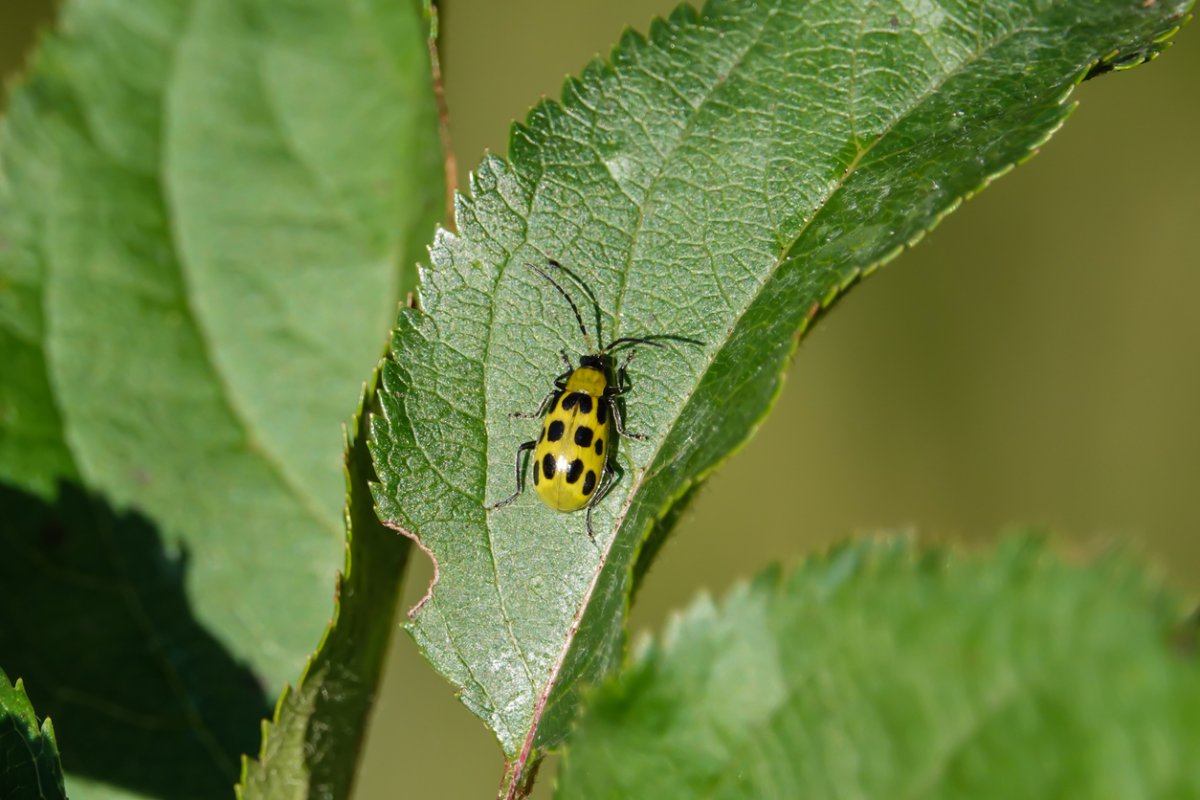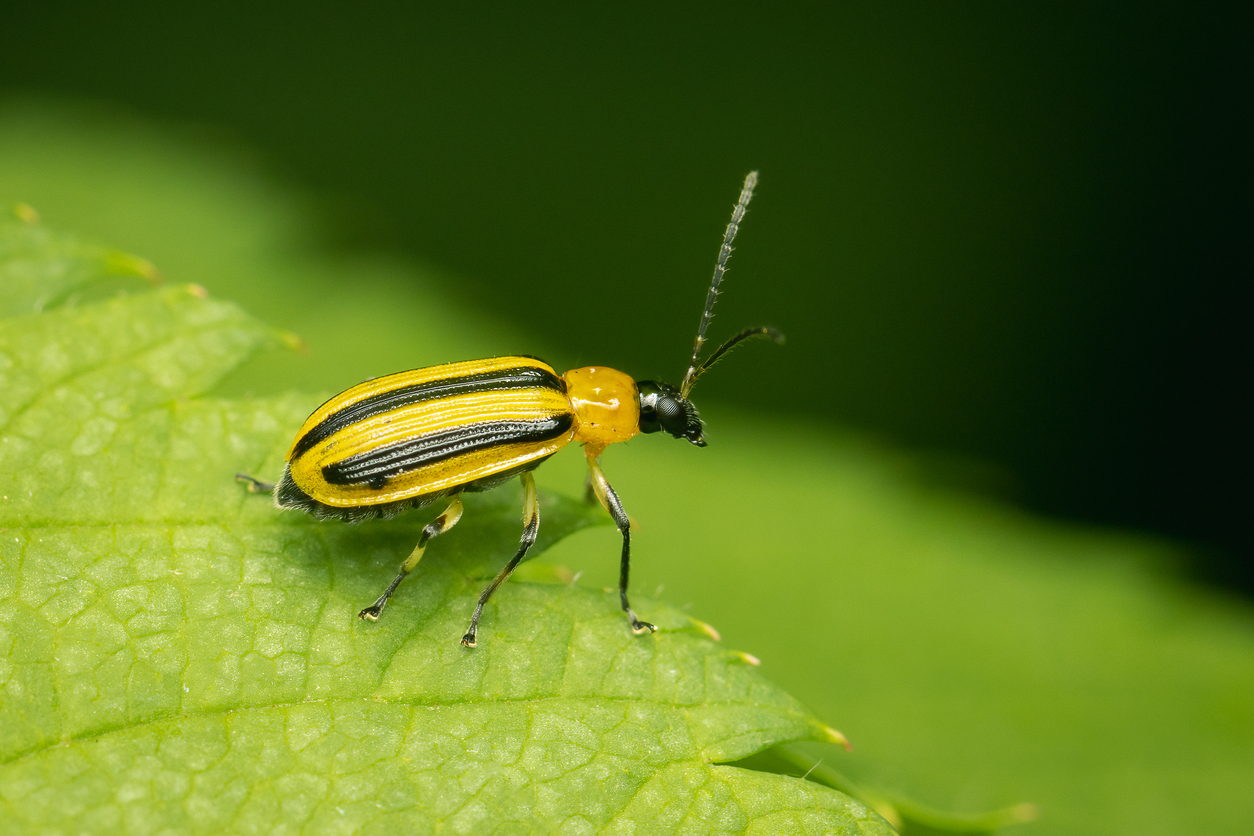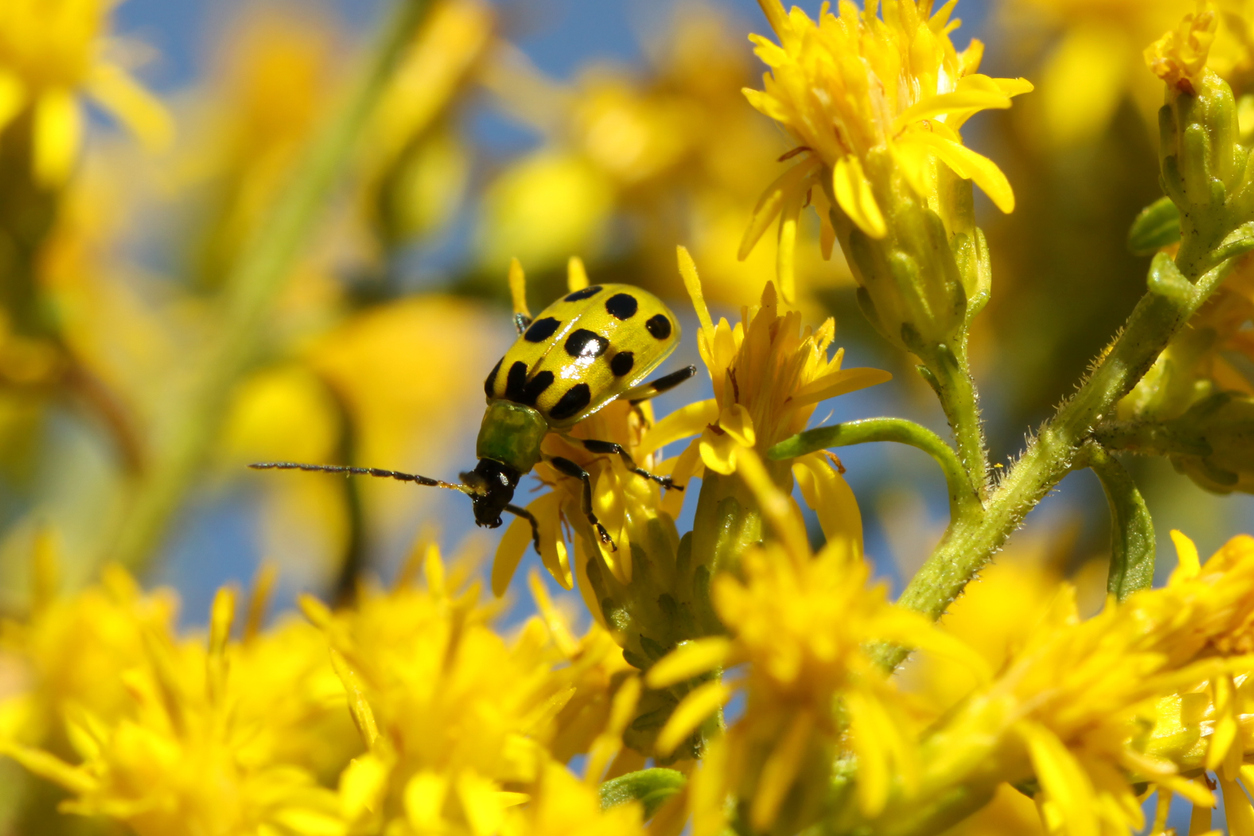

We may earn revenue from the products available on this page and participate in affiliate programs. Learn More ›
If your vining vegetables are crawling with striped or spotted beetles, chances are that they aren’t ladybugs but the yellow-bellied, er, yellow-backed villains of the insect world—cucumber beetles. Their somewhat sickly greenish-yellow hues hint at how ill they can make your plants.
When considering how to get rid of cucumber beetles, keep in mind that they generally do the most damage in late spring and early summer when seedlings are young and tender. Mature plants tolerate pests more easily. Although this article concentrates on the beetles’ effect on cucumber cultivation, the solutions suggested should work for other vegetables too.
How to Identify Cucumber Beetles
You can easily use beetle stripes or spots to identify which type of pest problem you have, though cucumber beetle control actually is similar for both varieties.
Striped Cucumber Beetle

The striped cucumber beetle (Acalymma vittatum) varies in length from 3/16 to 1/4 inch. Yellow in color, it has three vertical black stripes running down its back, as well as a black head, antenna, and abdomen. It spends the winter beneath leaf litter and emerges in late spring or early summer to lay tiny orange or yellow cucumber beetle eggs in the soil around the bases of your plants.
After hatching in a couple weeks or so, the white larvae with black heads feed on the plants’ roots before pupating in late summer. Although this small beetle prefers cucurbits—vining crops such as cucumbers, melons, squashes, and pumpkins—it often can be found on other vegetables and ornamental plants too.
Spotted Cucumber Beetle

Mostly similar in size and appearance to the striped beetle, the spotted cucumber bug (Diabrotica undecimpunctata howardi) comes in a greenish-yellow shade decorated with a dozen black spots instead of stripes. Because it can’t survive frigid winters, it migrates north in late June to early July, so it generally doesn’t cause as much cucumber carnage there as the striped version does.
However, the spotted type does feed on a wider range of plants than its striped “brother” and can inflict plenty of damage in the South, where more than one generation of beetles will be “hatched” over the course of a longer growing season.
Plant Damage
Cucumber beetle damage can be extensive since a heavy population of the insects may slaughter sprouting seedlings by consuming the new leaves and girdling (chewing all the way around) the stems. The beetles also interfere with pollination and fruit set by chowing down on the plants’ blooms.
However, the insects cause even more damage by transmitting the incurable bacterial wilt disease, which literally will cause plants to curl up and die. The cucurbits most affected by bacterial wilt are cucumbers and muskmelons. Although squashes are more resistant to the malady and have their own squash bugs with which they must contend, they can suffer from squash mosaic virus carried by cucumber beetles—which causes mottled leaves and distorted fruits.
How to Get Rid of Cucumber Beetles
Now that you know the devastation these insect pests can leave behind in your garden, how do you get rid of them? That isn’t easy since they are a bit too fast to make hand-picking of them effective. But there are a few steps you can take to reduce their populations.
Working Time: 1 hour
Total Time: 1 to 2 weeks
Skill Level: Beginner
Estimated Cost: $20 to $100
Tools & Materials
Bobvila.com may earn a commission from purchases made through these links.
STEP 1: Sow your cucumbers late outdoors or start them early indoors.
In the north, cucumber beetles emerge in late May or early June once soil temperatures have risen to 55 degrees Fahrenheit. Therefore, it’s a good idea to simply delay your planting of cucumbers until mid-June when most of those beetles should have moved on.
Alternatively, because young plants tend to be the most drastically affected, you may want to start your cucumbers in a greenhouse or under grow lights and wait to transplant them into the garden until they already have at least three true leaves. (True leaves are the leaves that appear after the initial two seedling leaves.)
RELATED: Don’t Kill These 17 Beneficial Insects in Your Garden
STEP 2: Place beetle traps or trap crops around your plot’s edges.
Meanwhile, 2 weeks before you intend to sow your cucumbers or set them out, place beetle traps baited with pheromones or beetle trap crops around the edges of your plot. Blue Hubbard squash is one of the most effective trap crops, though other types of winter squash or zucchini also will work.
When considering how to kill cucumber beetles that have been lured to those crops, keep in mind that you should spray them in the evening, because the beetles are more active at that time of day and because most beneficial insects should have flown away home by then.
STEP 3: Apply beneficial nematodes or purchase plants that attract beneficial insects.

Consider spraying beneficial nematodes into the soil around your seedlings as that can kill the beetles in their larval stage and reduce the population of those that emerge in late summer. The Rodale Institute suggests that you also include “insectary strips” of plants that attract beneficial insects in your pest control plans. Ornamentals and herbs such as alyssum, calendula, and lemon balm lure ladybugs, lacewings, and tachinid flies, which will prey on the beetles and/or their larvae.
STEP 4: Mulch young cucumber plants with silver reflective mulch or straw.
Reflective silver mulch reportedly repels insects such as cucumber beetles by confusing them—making them as blind as beetles, perhaps! Gardeners who use the mulch might want to wear sunglasses to protect their own vision from the glare. Once that mulch is mostly covered by plants, its effectiveness against insects wanes. Although straw will not repel cucumber beetles, it does make egg laying more difficult for them. In fact, almost any mulch will work for that purpose.
STEP 5: Cover cucumber plants with row cover until they begin blooming.
You can keep the beetles off your plants for a time by completely swathing the young plants with row cover, pinned down at the sides to prevent the insects’ entry, but still admits light. For this to be effective, you will need to apply the row cover immediately after you sow or transplant your cucumbers—preferably into a plot where cucurbits didn’t grow the previous year. However, you will need to remove the cover once the plants begin to bloom to allow bees to pollinate them, unless you plan on handling the pollinating duties yourself.
RELATED: 7 Types of Plant Covers All Home Gardeners Should Know
Ways to Prevent a Cucumber Beetle Infestation

Consider taking the following steps to help forestall future infestations of cucumber beetles.
- Clean up the litter and weeds in and around your garden in autumn to prevent the bugs from hibernating in it.
- Also, be sure that you rotate your crops every year—planting your cucurbits next spring in a different place than you did this spring to make it less easy for their hangers-on to find them again.
- You may also want to sow wilt-resistant cultivars of cucumber—such as ‘County Fair’ and ‘Cross Country.’
